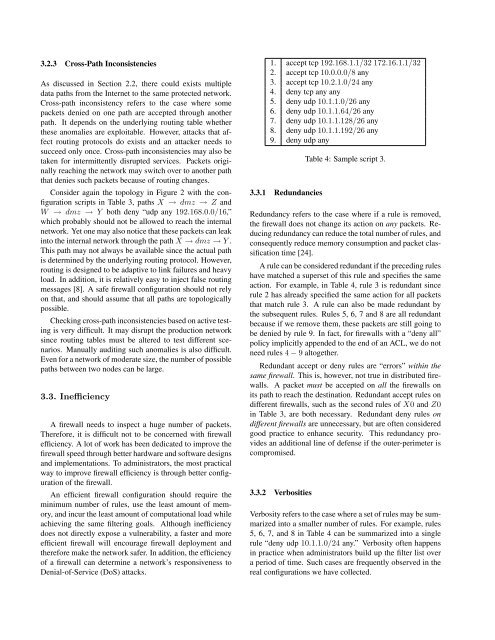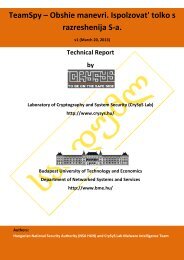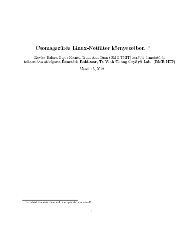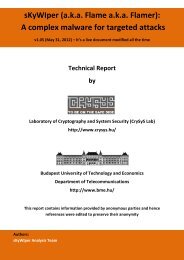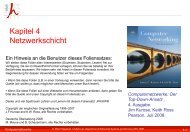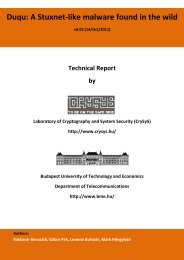FIREMAN: A Toolkit for FIREwall Modeling and ANalysis
FIREMAN: A Toolkit for FIREwall Modeling and ANalysis
FIREMAN: A Toolkit for FIREwall Modeling and ANalysis
You also want an ePaper? Increase the reach of your titles
YUMPU automatically turns print PDFs into web optimized ePapers that Google loves.
3.2.3 Cross-Path Inconsistencies<br />
As discussed in Section 2.2, there could exists multiple<br />
data paths from the Internet to the same protected network.<br />
Cross-path inconsistency refers to the case where some<br />
packets denied on one path are accepted through another<br />
path. It depends on the underlying routing table whether<br />
these anomalies are exploitable. However, attacks that affect<br />
routing protocols do exists <strong>and</strong> an attacker needs to<br />
succeed only once. Cross-path inconsistencies may also be<br />
taken <strong>for</strong> intermittently disrupted services. Packets originally<br />
reaching the network may switch over to another path<br />
that denies such packets because of routing changes.<br />
Consider again the topology in Figure 2 with the configuration<br />
scripts in Table 3, paths X → dmz → Z <strong>and</strong><br />
W → dmz → Y both deny “udp any 192.168.0.0/16,”<br />
which probably should not be allowed to reach the internal<br />
network. Yet one may also notice that these packets can leak<br />
into the internal network through the path X → dmz → Y .<br />
This path may not always be available since the actual path<br />
is determined by the underlying routing protocol. However,<br />
routing is designed to be adaptive to link failures <strong>and</strong> heavy<br />
load. In addition, it is relatively easy to inject false routing<br />
messages [8]. A safe firewall configuration should not rely<br />
on that, <strong>and</strong> should assume that all paths are topologically<br />
possible.<br />
Checking cross-path inconsistencies based on active testing<br />
is very difficult. It may disrupt the production network<br />
since routing tables must be altered to test different scenarios.<br />
Manually auditing such anomalies is also difficult.<br />
Even <strong>for</strong> a network of moderate size, the number of possible<br />
paths between two nodes can be large.<br />
3.3. Inefficiency<br />
A firewall needs to inspect a huge number of packets.<br />
There<strong>for</strong>e, it is difficult not to be concerned with firewall<br />
efficiency. A lot of work has been dedicated to improve the<br />
firewall speed through better hardware <strong>and</strong> software designs<br />
<strong>and</strong> implementations. To administrators, the most practical<br />
way to improve firewall efficiency is through better configuration<br />
of the firewall.<br />
An efficient firewall configuration should require the<br />
minimum number of rules, use the least amount of memory,<br />
<strong>and</strong> incur the least amount of computational load while<br />
achieving the same filtering goals. Although inefficiency<br />
does not directly expose a vulnerability, a faster <strong>and</strong> more<br />
efficient firewall will encourage firewall deployment <strong>and</strong><br />
there<strong>for</strong>e make the network safer. In addition, the efficiency<br />
of a firewall can determine a network’s responsiveness to<br />
Denial-of-Service (DoS) attacks.<br />
1. accept tcp 192.168.1.1/32 172.16.1.1/32<br />
2. accept tcp 10.0.0.0/8 any<br />
3. accept tcp 10.2.1.0/24 any<br />
4. deny tcp any any<br />
5. deny udp 10.1.1.0/26 any<br />
6. deny udp 10.1.1.64/26 any<br />
7. deny udp 10.1.1.128/26 any<br />
8. deny udp 10.1.1.192/26 any<br />
9. deny udp any<br />
3.3.1 Redundancies<br />
Table 4: Sample script 3.<br />
Redundancy refers to the case where if a rule is removed,<br />
the firewall does not change its action on any packets. Reducing<br />
redundancy can reduce the total number of rules, <strong>and</strong><br />
consequently reduce memory consumption <strong>and</strong> packet classification<br />
time [24].<br />
A rule can be considered redundant if the preceding rules<br />
have matched a superset of this rule <strong>and</strong> specifies the same<br />
action. For example, in Table 4, rule 3 is redundant since<br />
rule 2 has already specified the same action <strong>for</strong> all packets<br />
that match rule 3. A rule can also be made redundant by<br />
the subsequent rules. Rules 5, 6, 7 <strong>and</strong> 8 are all redundant<br />
because if we remove them, these packets are still going to<br />
be denied by rule 9. In fact, <strong>for</strong> firewalls with a “deny all”<br />
policy implicitly appended to the end of an ACL, we do not<br />
need rules 4 − 9 altogether.<br />
Redundant accept or deny rules are “errors” within the<br />
same firewall. This is, however, not true in distributed firewalls.<br />
A packet must be accepted on all the firewalls on<br />
its path to reach the destination. Redundant accept rules on<br />
different firewalls, such as the second rules of X0 <strong>and</strong> Z0<br />
in Table 3, are both necessary. Redundant deny rules on<br />
different firewalls are unnecessary, but are often considered<br />
good practice to enhance security. This redundancy provides<br />
an additional line of defense if the outer-perimeter is<br />
compromised.<br />
3.3.2 Verbosities<br />
Verbosity refers to the case where a set of rules may be summarized<br />
into a smaller number of rules. For example, rules<br />
5, 6, 7, <strong>and</strong> 8 in Table 4 can be summarized into a single<br />
rule “deny udp 10.1.1.0/24 any.” Verbosity often happens<br />
in practice when administrators build up the filter list over<br />
a period of time. Such cases are frequently observed in the<br />
real configurations we have collected.


